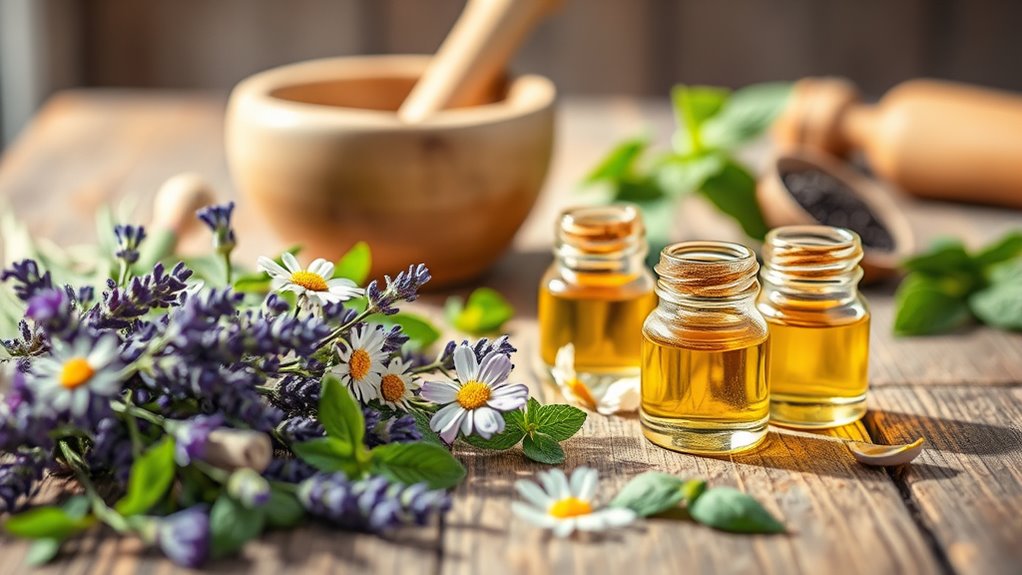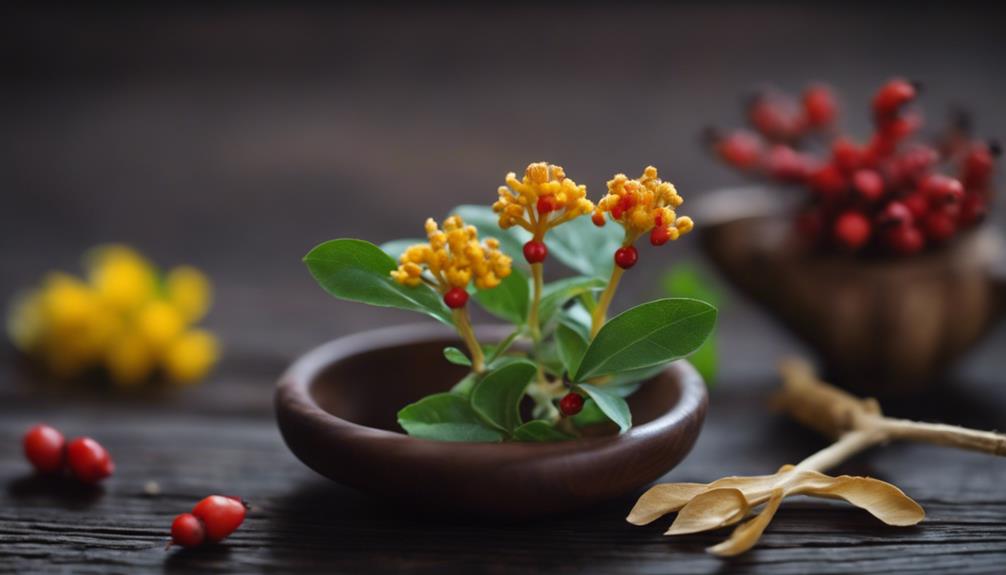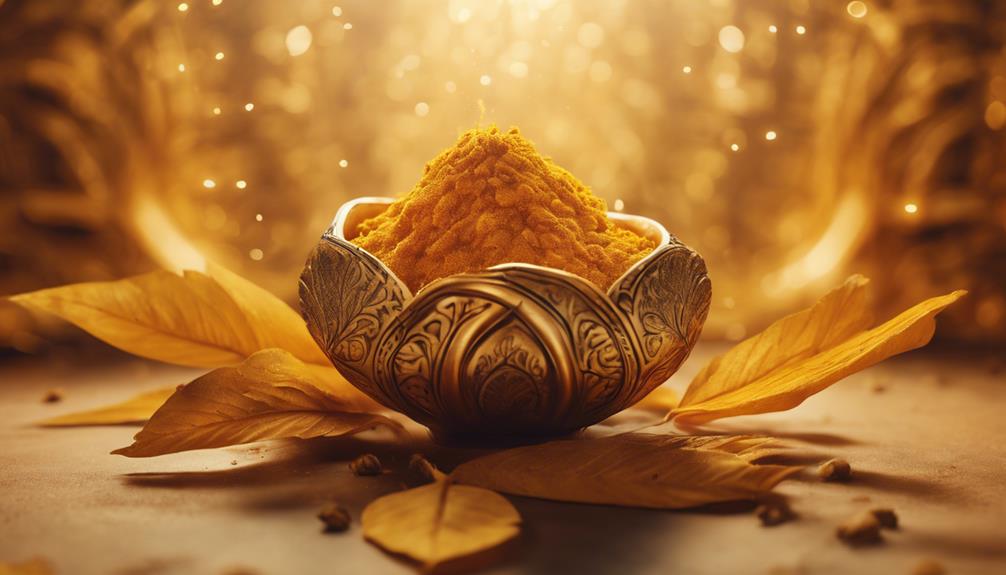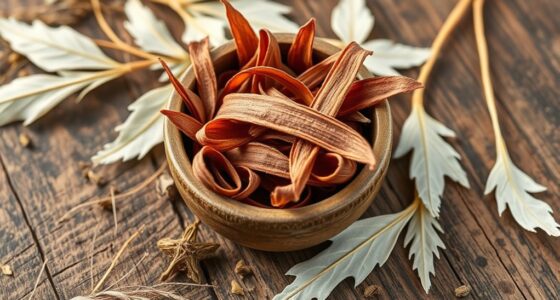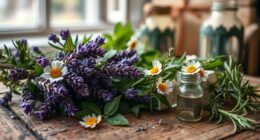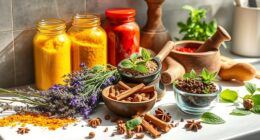Herbal muscle relaxers work by calming your nervous system and reducing inflammation, helping to ease tense muscles naturally. Common herbs include valerian root, passionflower, chamomile, peppermint, and kava kava, often used in teas, topical applications, or supplements across different cultures. They offer benefits like fewer side effects and addressing root causes of tension. Combining herbs can boost their effects, but it’s important to choose high-quality formulations and consider safety. Discover more ways to promote muscle relaxation naturally below.
Key Takeaways
- Herbal muscle relaxers interact with neural pathways to naturally reduce muscle tension and spasms.
- Common herbs like valerian, passionflower, chamomile, peppermint, and kava are traditionally used for relaxation.
- Scientific studies support herbs’ effectiveness in easing muscle spasms and pain with fewer side effects than pharmaceuticals.
- Combining herbs can enhance relaxation, but choosing high-quality, pure, and transparent formulations ensures safety.
- Always consult healthcare providers before use to prevent interactions and monitor for allergic reactions or adverse effects.
How Herbal Muscle Relaxers Work in the Body

Herbal muscle relaxers work by targeting the nervous system and reducing muscle tension naturally. When you take these herbs, they interact with your body’s neural pathways, helping to calm overactive nerves that cause spasms and tightness. Many herbs contain compounds that influence neurotransmitter activity, promoting relaxation without harsh side effects. This helps your muscles loosen up, easing pain and stiffness. Instead of masking symptoms with chemicals, herbal relaxers support your body’s natural balance. They may also reduce inflammation and improve circulation, further relieving discomfort. By calming the nervous signals that trigger muscle tightening, herbal relaxers offer a gentle, holistic approach to muscle relaxation. This makes them a popular choice for those seeking a safer, more natural way to manage muscle spasms and tension.
Top Herbs Used for Muscle Relaxation
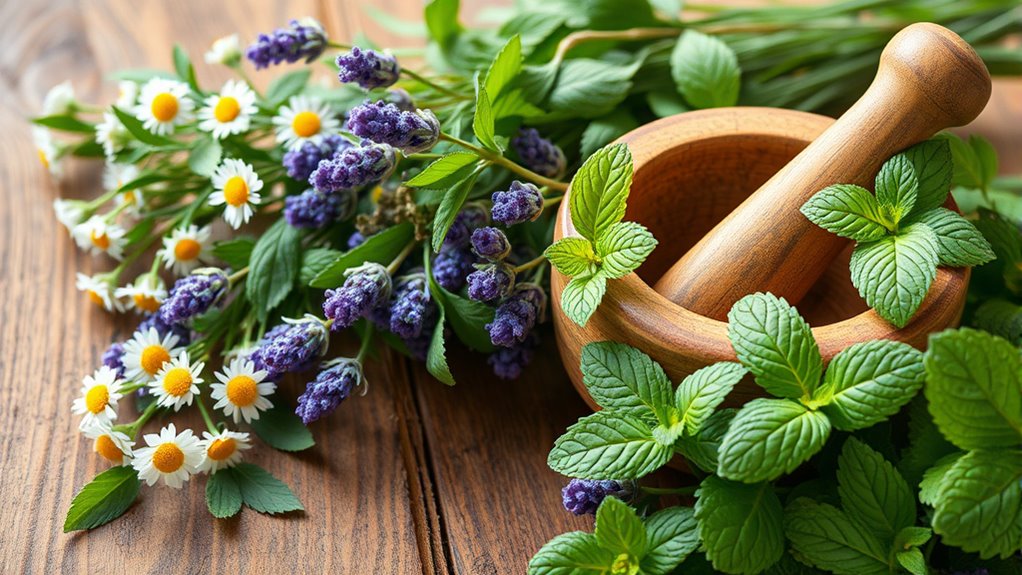
Many herbs are renowned for their ability to promote muscle relaxation naturally. Valerian root is one of the most popular, known for calming nerves and easing spasms. Passionflower helps reduce tension and relaxes tight muscles, making it a great choice for spasms. Chamomile is not only soothing for the mind but also relaxes muscles through its anti-inflammatory properties. Peppermint contains menthol, which relaxes muscles and relieves stiffness. Kava kava is another powerful herb that reduces muscle tension and promotes calmness, though it should be used cautiously. These herbs can be incorporated into teas, tinctures, or capsules, offering natural relief without the side effects often associated with pharmaceuticals. Always consult a healthcare professional before adding new herbs to your routine.
Benefits of Choosing Natural Alternatives Over Pharmaceuticals

Choosing natural alternatives for muscle relaxation can often be a safer and more sustainable option than relying on pharmaceuticals. Natural remedies typically have fewer side effects, reducing your risk of dependency or adverse reactions. Herbs like valerian or chamomile work gently, supporting your body’s own healing processes without overwhelming your system. Plus, natural options are accessible and often more affordable, making them a practical choice for ongoing relief. They also promote overall well-being by addressing underlying issues rather than just masking symptoms. When you choose herbal remedies, you’re taking control of your health with a proactive, holistic approach. This shift can lead to fewer medication-induced complications and a more balanced, sustained relief from muscle spasms.
Combining Herbs for Enhanced Effectiveness

Combining different herbs can markedly enhance their muscle-relaxing effects, providing more thorough relief. When you mix herbs like valerian, passionflower, and hops, their combined properties can target spasms more effectively. This synergy may reduce the need for higher doses of individual herbs, lowering potential side effects. To visualize, here’s a simple combination:
| Herb | Main Benefit | Best Used With |
|---|---|---|
| Valerian | Relieves muscle tension | Passionflower, chamomile |
| Passionflower | Eases anxiety and spasms | Valerian, lemon balm |
| Hops | Promotes relaxation | Valerian, lemon balm |
Experimenting with these combinations allows you to tailor relief, maximizing relaxation naturally.
Safety Considerations and Potential Side Effects

You should be aware that herbal muscle relaxers can cause allergic reactions in some people, so watch for signs like rash or swelling. Additionally, these herbs might interact with medications you’re already taking, leading to unwanted side effects. Always consult with a healthcare professional before starting any new herbal remedy to guarantee safety.
Possible Allergic Reactions
While herbal muscle relaxers are often considered a natural alternative, they can still trigger allergic reactions in some people. You might experience symptoms like skin rashes, itching, swelling, or difficulty breathing after taking them. Even natural ingredients can cause sensitivities, especially if you have allergies to certain plants or herbs. It’s important to start with a small dose to see how your body reacts. If you notice any allergic symptoms, stop using the herb immediately and seek medical help. Keep in mind that reactions can vary from mild to severe, so never ignore early signs. Always read labels carefully, and consult your healthcare provider if you have known allergies or concerns before trying herbal muscle relaxers.
Drug Interactions to Watch
Even though herbal muscle relaxers are natural options, they can still interact with other medications, leading to unintended side effects or reduced effectiveness. For example, combining them with sedatives or antihistamines can increase drowsiness or dizziness. Some herbs, like valerian or passionflower, may amplify the effects of medications that depress your central nervous system, risking excessive sedation. Conversely, certain herbs might interfere with blood thinners or medications for hypertension, reducing their efficacy. It is crucial to talk to your healthcare provider before adding herbal relaxers to your routine, especially if you’re on prescription medications. Monitoring for unusual symptoms, such as increased fatigue or blood pressure changes, helps prevent adverse interactions. Always prioritize safety and seek professional guidance when combining herbal remedies with other drugs.
Methods of Incorporating Herbal Relaxers Into Your Routine
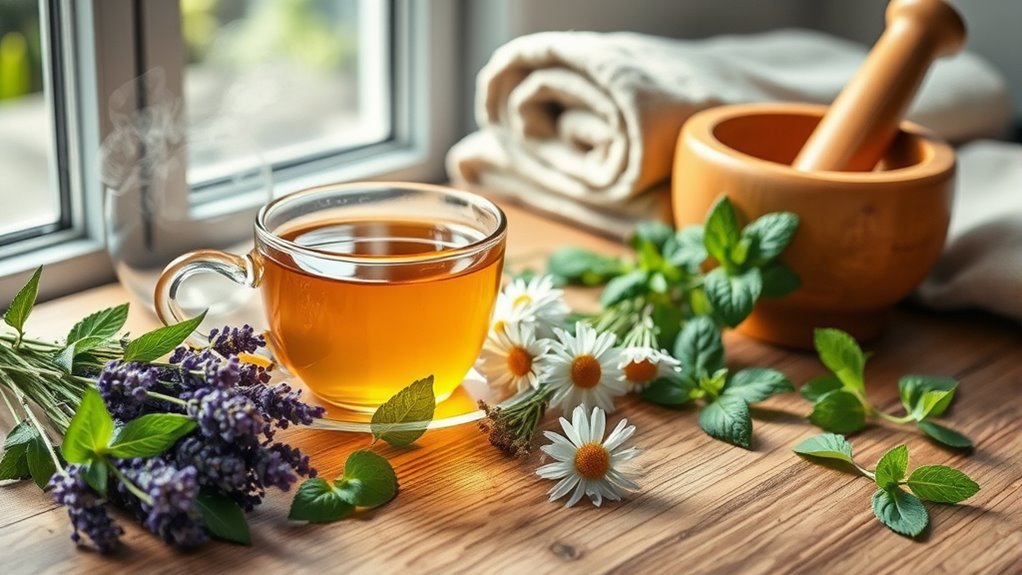
There are several effective ways to include herbal relaxers in your routine, such as brewing herbal teas or taking supplements. You can also apply topical remedies directly to sore muscles for targeted relief. Choosing the right method depends on your preferences and safety considerations, so it’s important to understand each option.
Herbal Tea Preparations
Incorporating herbal relaxers into your routine through tea is a simple and effective way to enjoy their calming benefits. To prepare herbal teas, steep dried herbs like chamomile, valerian, or lemon balm in hot water for 5-10 minutes. Strain the tea and sip slowly to relax tense muscles. You can enhance the flavor with honey or lemon if desired. Drinking herbal tea regularly can help reduce spasms and promote relaxation. Here’s a quick idea guide:
| Herb | Best Use |
|---|---|
| Chamomile | Calm nerves and muscles |
| Valerian | Deep relaxation, sleep aid |
| Lemon Balm | Stress relief, muscle tension |
| Peppermint | Soothes muscles, digestion |
| Passionflower | Reduce spasms, anxiety |
Incorporating Supplements Safely
To safely include herbal relaxers in your routine, start by consulting with a healthcare professional to guarantee they won’t interact with any medications or health conditions. Follow recommended dosages carefully to avoid adverse effects. Incorporate supplements gradually, monitoring how your body responds before increasing intake. Use a consistent schedule to help your body adapt and recognize the effects. Keep track of any side effects or changes in symptoms, and report these to your healthcare provider. Choose reputable brands that provide transparent ingredient lists and quality assurance. Combining herbal relaxers with other treatments should be done cautiously, ensuring they complement your overall pain management plan. Prioritizing safety helps you enjoy the benefits of herbal supplements without unnecessary risks.
Topical Application Techniques
Applying herbal relaxers topically offers a targeted approach to easing muscle tension and pain. You can use creams, ointments, or essential oils to directly target affected areas. Start by cleaning the skin, then gently massage the herbal preparation into your muscles. Cover the area with a cloth or bandage if needed to enhance absorption. Be sure to test a small patch first to check for sensitivity. Consistency is key—apply at the first sign of discomfort or as part of your routine. Here’s a quick guide:
| Method | Preparation | Tips |
|---|---|---|
| Creams & Ointments | Apply a thin layer | Use gentle massage |
| Essential Oils | Dilute with carrier oil | Avoid sensitive areas |
| Compresses | Soak cloth, apply heat | Use for deep relief |
Traditional Uses of Muscle-Relieving Herbs Across Cultures

Across various cultures, people have long relied on herbal remedies to soothe muscle tension and promote relaxation. In traditional Chinese medicine, herbs like ginger and turmeric are used to reduce inflammation and ease spasms. Native Americans have historically used willow bark and black cohosh for muscle pain relief. In Ayurvedic practices, ashwagandha and brahmi are valued for their calming effects on the nervous system. European folk medicine often employed chamomile and valerian root to relax muscles and reduce spasms. These herbs were typically prepared as teas, poultices, or infusions, applied or consumed to promote overall muscle health. While methods vary, the common goal across cultures remains the same: harness natural plant properties to alleviate muscle discomfort and support relaxation.
Scientific Research Supporting Herbal Muscle Relaxants
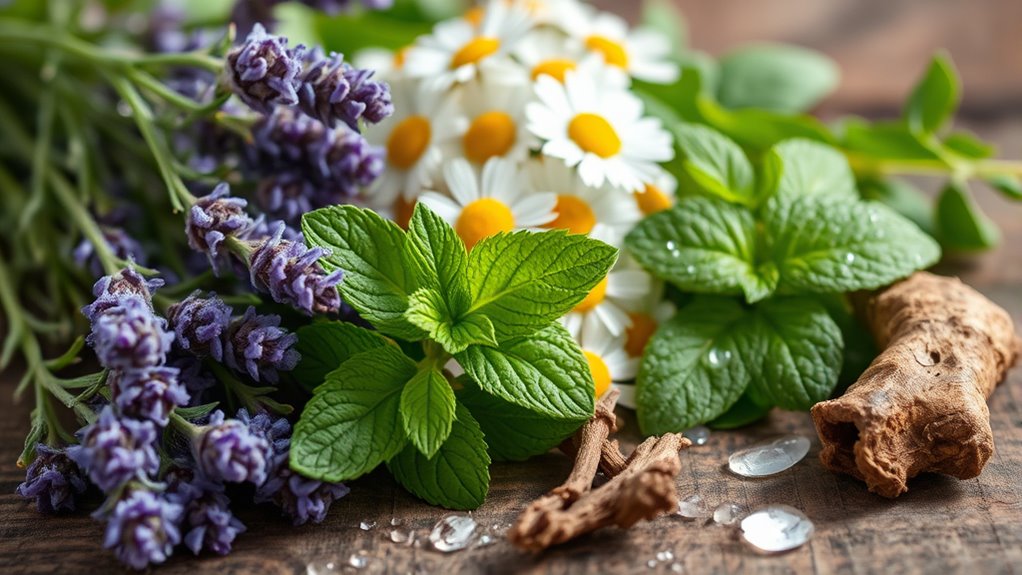
Scientific studies increasingly confirm the muscle-relieving effects of various herbs, providing evidence that supports their traditional uses. Research shows that herbs like valerian root, passionflower, and kava contain compounds that relax muscles and reduce spasms. For example, clinical trials demonstrate that valerian’s calming properties can ease muscle tension and improve flexibility. Similarly, kava has been shown to inhibit nerve signaling linked to muscle contractions, helping to relax tense muscles naturally. You can find scientific data backing these herbs’ effectiveness in peer-reviewed journals, where researchers measure reductions in muscle spasms and pain after herbal treatment. This growing body of evidence highlights that herbal muscle relaxants are not just folk remedies but viable options supported by scientific validation.
Tips for Selecting Quality Herbal Supplements

When choosing herbal supplements, you want to make certain you’re getting a pure and effective product. Look for products that verify ingredient purity and have proper certification to guarantee quality. Also, assess whether the formulations are natural and free from unnecessary additives for the best results.
Verify Ingredient Purity
To guarantee you’re getting the highest quality herbal muscle relaxers, it’s essential to verify the purity of their ingredients. Start by checking the product label for transparency about sourcing and manufacturing practices. Look for herbal extracts that are labeled as organic or non-GMO, which reduces the risk of contaminants. Avoid supplements with artificial fillers, binders, or unnecessary additives. Reputable brands often conduct third-party testing to verify ingredient purity and potency. You can also research the supplier’s reputation and reviews from other users. If possible, choose products that provide detailed information about their ingredients and testing procedures. Verifying ingredient purity helps ensure you’re safely benefiting from the herbal ingredients without exposure to harmful contaminants.
Check for Certification
After verifying ingredient purity, the next step is to check for certification from reputable organizations. Certifications guarantee the herbal supplement meets quality standards and safety protocols. Look for labels like USDA Organic, NSF International, or USP Verified. These mark trusted quality control measures. To help you decide, consider this quick guide:
| Certification | Meaning | Benefits |
|---|---|---|
| USDA Organic | Grown without pesticides | Pure, pesticide-free herbs |
| NSF International | Safety & quality testing | Reliable, contaminant-free products |
| USP Verified | Meets potency & purity standards | Consistent, effective supplements |
| Non-GMO | No genetically modified ingredients | Natural, unaltered herbs |
| GMP Certified | Good Manufacturing Practices | Safe, well-produced products |
Choosing supplements with proper certification guarantees you’re getting a safe, high-quality herbal relaxer for your needs.
Assess Natural Formulations
Evaluating natural formulations is essential to guarantee you’re choosing a high-quality herbal muscle relaxer. Look closely at the ingredients list to ensure they contain recognizable, natural herbs known for muscle relaxation, like valerian or passionflower. Check for transparency about sourcing and manufacturing processes, which indicates quality control. Avoid products with artificial fillers, preservatives, or synthetic additives that could diminish effectiveness or cause side effects. Consider formulations with standardized extracts, as they guarantee consistent potency. Ultimately, research the specific herbs included to verify their safety and proven benefits for muscle spasms. By paying attention to these details, you can confidently select a supplement that’s both effective and safe for easing your muscle discomfort.
Lifestyle Factors That Support Muscle Health and Relaxation
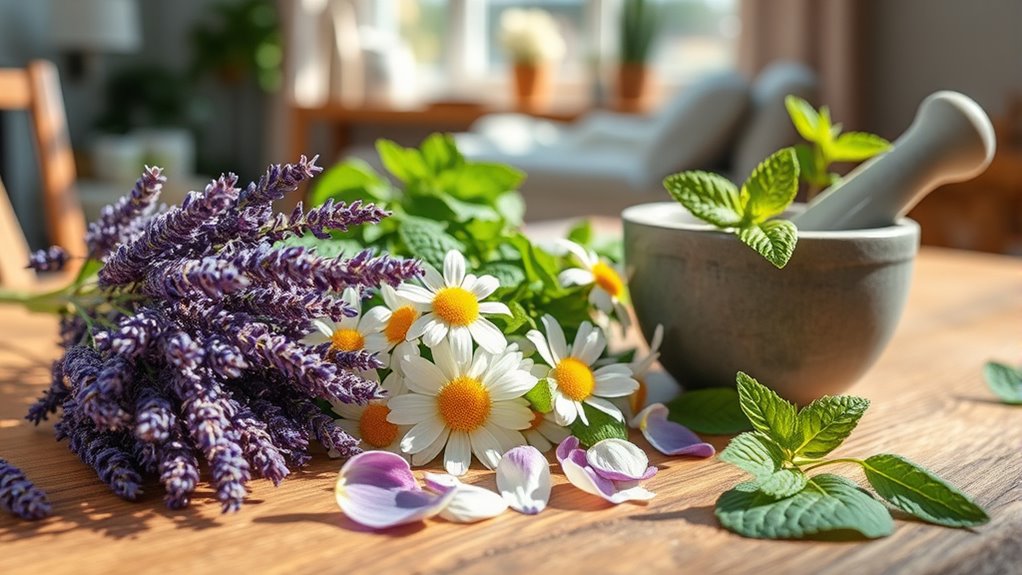
Maintaining muscle health and promoting relaxation often depends on lifestyle choices that support your overall well-being. Regular exercise, especially stretching and low-impact activities like yoga or walking, helps keep muscles flexible and reduces spasms. Staying hydrated is essential, as dehydration can lead to cramps and stiffness. Prioritize balanced nutrition with plenty of magnesium, potassium, and calcium, which are indispensable for muscle function. Adequate sleep allows your muscles to recover and relax naturally. Managing stress through mindfulness or deep breathing can decrease muscle tension. Avoid prolonged sitting or repetitive movements that strain muscles. By incorporating these habits, you create a supportive environment for muscle health, reduce the likelihood of spasms, and enhance your body’s natural ability to relax.
Frequently Asked Questions
Can Herbal Muscle Relaxers Replace Prescribed Medications Safely?
Herbal muscle relaxers can complement prescribed medications but shouldn’t substitute them without your doctor’s approval. You might find relief with natural remedies, but safety and effectiveness vary. Always consult your healthcare provider before making changes to your treatment plan. They can ensure herbal options won’t interfere with your medications or medical conditions, helping you manage spasms safely and effectively.
Are There Any Long-Term Effects of Using Herbal Relaxers Regularly?
Yes, long-term use of herbal relaxers can have effects. You might develop allergic reactions or digestive issues over time. Some herbs could interact with medications you’re taking, potentially causing complications. Regular use might also lead to dependence on herbal remedies for relaxation, reducing your body’s natural ability to manage spasms. To stay safe, consult a healthcare professional regularly, especially if you notice any adverse effects or if you plan to use them long-term.
Which Herbs Are Best for Specific Muscle Groups or Types of Spasms?
You should try valerian or passionflower for general muscle relaxation, especially if you experience neck or shoulder spasms. For lower back cramps, ginger and turmeric can help reduce inflammation. For leg cramps, consider magnesium-rich herbs like basil or chamomile. Focus on herbs that target your specific muscle group and type of spasm, and always consult a healthcare professional before adding new herbs to your routine to guarantee safety.
Can Herbal Relaxers Interact With Other Medications or Supplements?
Yes, herbal relaxers can interact with other medications or supplements. You might experience increased drowsiness, dizziness, or other side effects if you mix them with sedatives, blood thinners, or antidepressants. Always check with your healthcare provider before combining herbal remedies with your current medications. Being cautious helps prevent harmful interactions and guarantees you get the relief you need safely.
What Are Signs of Adverse Reactions to Herbal Muscle Relaxers?
You should watch for signs of adverse reactions like dizziness, excessive drowsiness, nausea, or allergic symptoms such as rash or swelling. If you experience difficulty breathing, chest tightness, or severe stomach pain, seek medical help immediately. These symptoms indicate your body isn’t reacting well to the herbal relaxer. Always start with a small dose, and consult your healthcare provider if you notice any unusual or severe side effects.
Conclusion
By choosing herbal muscle relaxers, you’re not just easing spasms—you’re inviting nature’s gentle touch to soothe your body’s story. Imagine a calming breeze flowing through tense muscles, offering relief without harsh chemicals. With the right herbs and mindful lifestyle choices, you can turn pain into peace naturally. Embrace these botanical allies and let your body dance freely again, guided by the wisdom of nature’s timeless remedy.

